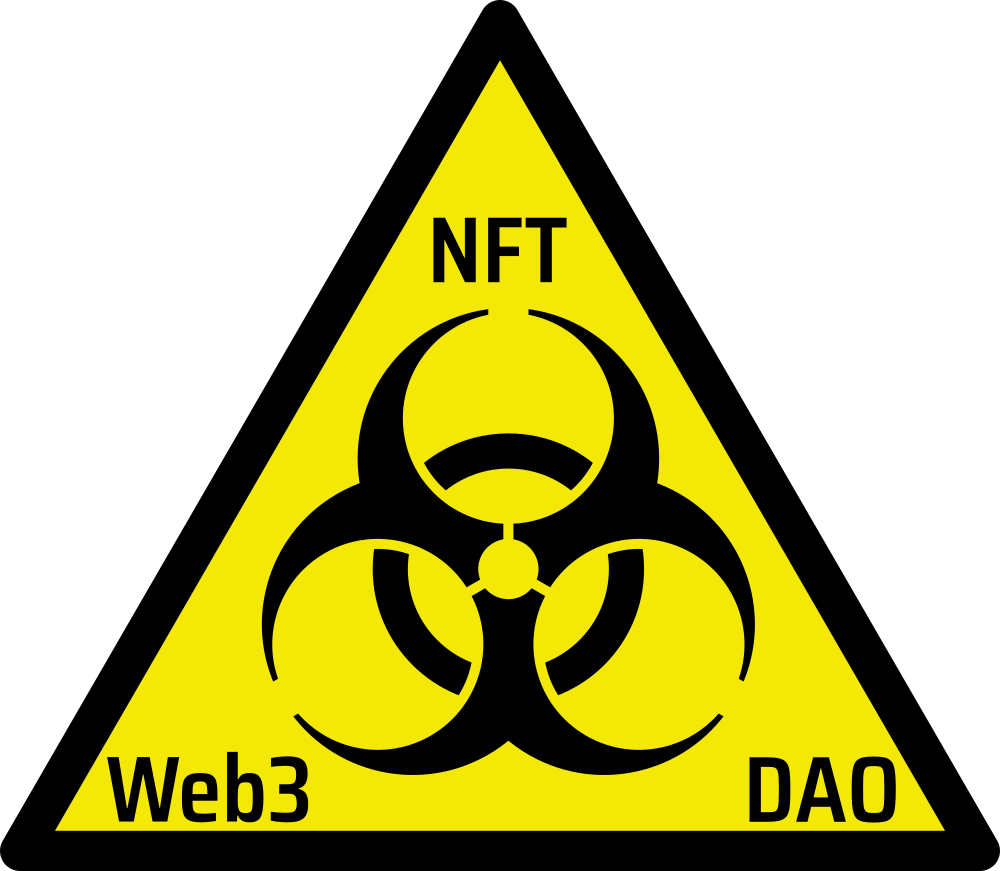Susanna Petrin closes her NFT experiment with a dystopia of life after we destroyed our environment: Admiring our NFTs while strolling through the metaverse.
I hope we can avert both.
A German 🇩🇪 version of this article is available here. Or read more around the blockchain economy.
1. Avert the destruction
The challenges are many. Some result in a big impact, some in small. Orthogonally, some require a big sacrifice, others don’t.
The Crypto”currencies” underlying NFTs consume energy costing millions and millions of Swiss Francs (or USD or …) every day. In relation to our global energy consumption, this may not be a big fish. However, the sacrifices our society have to pay for their elimination, is negligible. On the contrary, besides the elimination of the ecological costs it would also eliminate the economic and social costs paid by the ultimate losers in this “crypto” gamble.
2. Avert NFTs
NFTs have no real value, despite being marketed like that. Especially to people, who do not have the means for high-risk investment. Why? Because NFTs are often misunderstood.
- The digital revolution is based on efficiency gain, especially the highly efficient copying of anything digital. Every bit of a digital medium (text, still/moving image, sound, …) can be copied seamlessly and perfectly any number of times. Already an “ordinary” replay of such media (from a server over the Internet and your local computer to the final output device) creates dozens to hundreds of copies in the process. On that level, there is no distinction whatsoever between “good” (necessary) and “evil” (improper) copying. Every copy is indistinguishable from each other and the original. Even the one labelled “original” often is may copies away from the first bit pattern created, but still is as immaculate as any other copy that came before and will come after. [This item added 2022-06-20, as many people some to be unaware of this.]
- The digital “certificate of authenticity” isn’t. Therefore, it can never be better than its traditional pen-and-paper sibling. Furthermore, they are created as «smart contract», meaning plenty of them are plagued by unfixable errors or may conflict with copyright law.
- Your NFT does not point to the actual artwork, but just to a boring URL. Therefore, the content that you’re accessing can be modified at will or even be deleted or lost. Furthermore, there is no technical limit to create any number of copies (hey, it’s digital!).
- Young artists can become visible without NFT or Blockchain. All you need is a web page.
- Visibility is not created by the NFT technology, but through hype, PR, and celebrities.
- The apparently high prices (for some artworks) are the result of those few, who have nothing useful to do with their crypto assets (see below) or through so-called Wash Trades (selling the asset to yourself to pretend inflated market prices).
Crypto”currencies” are missing many crucial criteria which people expect from a currency.
One aspect is the lack of closed monetary circuits: If a company were to pay their employees with crypto assets, they would be unable to buy staple food from stores which would in pay their manufacturers in turn with cryptos, which in turn could pay their employees so they can buy other basic needs …; you get the problem.
All the while (1) millions in apparent crypto assets are created out of thin air on a daily basis and (2) horrendous power bills accrue. The lack of closed circulation implies millions in real dollar value exits the system every day.
- The very few which really made a lot of money, would also like to fulfill their daily needs (and treat themselves or friends and family to the odd luxury item). Neither is possible with cryptos.
- The excessive power bills also need to be paid in traditional currency. This requires additional “foreign trade deficit”, to borrow the currency terminology.
The alleged massive market capitalizations of these cryptos is not worth the bits it is printed on.
Traditional currencies like US Dollar cannot flow out of the Crypto Economy forever. New currency has to flow in as well. Where do they come from?
In my opinion, a major reason for the Web3 and NFT hypes are the need to get fresh money into that (dysfunctional) economy. Otherwise, early adopters or whales could not realize their gains. Entering now is highly risky, as – like in a Ponzi scheme – the devil takes the hindmost. (David Gerard explains that Bitcoin is not a Ponzi scheme, it just works like one. However, Sal Bayat goes further and claims it looks like the perfect scam.)
Further reading
(Besides some of my other articles in this field, of course)
- Amy Castor: “ A16z’s ‘State of Crypto’ report: A rehash of bad crypto market pitches“, 2022-05-19.
How Venture Capital makes money off crypto. - Web2 Boomer (pseudonym): “The Technical Problem With NFTs: 5 shortcomings you should know“, Better Programming, 2022-05-26.
Five misconceptions about NFTs. - Jörg Heiser: “Das Ding-Dong-Happy-Happy-Produkt“, Republik, 2022-06-09.
Part 1 of his NFT articles, in German. - Jörg Heiser: “Von der Tulpenzwiebel zur Datei“, Republik, 2022-06-10.
Part 2 of his NFT articles, in German. - Robert McCauley: “Why bitcoin is worse than a Madoff-style Ponzi scheme“, Financial Times, 2021-12-22.
Monetary outflow for energy makes it a negative-sum game; worse than Ponzi, which is zero-sum. - Sal Bayat: “The strange case of Nakamotos Bitcoin – Part 1“, 2022-06-08.
If Bitcoin were designed as the perfect scam, it probably would look exactly like as it does. [However, I doubt that this was the purpose or goal, but even the accidental result is impressive]. - Miles Carlsten, Harry Kalodner, S. Matthew Weinberg, and Arvind Narayanan: “On the Instability of Bitcoin Without the Block Reward“, ACM CCS 2016.
When transaction fees become relevant income, as opposed to the block reward (which provides for 98-99% of the Miner income today), forking the blockchain often may have higher economic incentive than continuing the existing longest branch.
Blockchain ecosystem
More posts in the blockchain ecosystem here, with the latest here:
- The year in reviewThis is the time to catch up on what you missed during the year. For some, it is meeting the family. For others, doing snowsports. For even others, it is cuddling up and reading. This is an article for the latter.
- NFTs are unethicalAs an avid reader, you know my arguments that neither NFT nor smart contracts live up to their promises, and that the blockchain underneath is also more fragile and has a worse cost-benefit ratio than most believe. Similarly, I also claim the… Read more: NFTs are unethical
- Inefficiency is bliss (sometimes)Bureaucracy and inefficiency are frowned upon, often rightly so. But they also have their good sides: Properly applied, they ensure reliability and legal certainty. Blockchain disciples want to “improve” bureaucracy-ridden processes, but achieve the opposite. Two examples:
- The FTX crypto exchange and its spider webYesterday, the U.S. Securities and Exchange Commission (SEC) released its indictment against Sam Bankman-Fried. It details the financial entanglements of FTX, Alameda Research and more than a hundred other companies and individuals. We have tried to disentangle these allegations somewhat for you.
- Web3 for data preservation? (Or is it just another expensive P2P?)Drew Austin raises an important question in Wired: How should we deal with our accumulated personal data? How can we get from randomly hoarding to selection and preservation? And why does his proposed solution of Web3 not work out? A few analytical… Read more: Web3 for data preservation? (Or is it just another expensive P2P?)
- Rejuvenation for Pro Senectute through NFT and Metaverse?Pro Senectute beider Basel, a foundation to help the elderly around Basel, launched its NFT project last week and already informed about its Metaverse commitment beforehand. According to a media release, Michael Harr, managing director of the 15-million Basel-based company, wants to… Read more: Rejuvenation for Pro Senectute through NFT and Metaverse?









